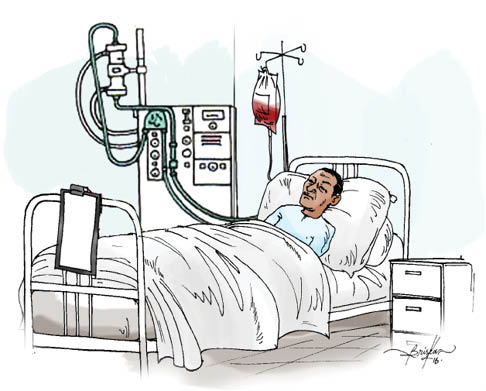Kindly discuss kidney transplant to your readers
Compliments of the season and kudos to you for your hard work and commitment to humanity. I saw you recently in a television programme discussing kidney transplantation. Kindly provide details to your teeming readers. Catherine X. Thanks, Catherine, for your kind words. Kidney transplant is a surgical procedure to place a healthy kidney from a […]

Compliments of the season and kudos to you for your hard work and commitment to humanity. I saw you recently in a television programme discussing kidney transplantation. Kindly provide details to your teeming readers.
Catherine X.
Thanks, Catherine, for your kind words. Kidney transplant is a surgical procedure to place a healthy kidney from a living or deceased donor into a person whose kidneys no longer function properly. Kidneys are two bean-shaped organs located on each side of the spine just below the rib cage.
Each is about the size of a fist. Their main function is to filter and remove waste minerals and fluid from the blood by producing urine. When kidneys lose this filtering ability, harmful levels of fluid and waste accumulate in the body, which can raise blood pressure and result in kidney failure.
Common causes of kidney failure include:
• Diabetes
• Chronic, uncontrolled high blood pressure
• Chronic glomerulonephritis, an inflammation and eventual scarring of the tiny filters within the kidneys (glomeruli)
• Polycystic kidney disease
People with kidney failure need to have waste removed from their bloodstream via a machine (dialysis) or a kidney transplant to stay alive.
Types of kidney transplants
1. Deceased-donor kidney transplant. A deceased-donor kidney transplant is when a kidney from someone who has recently died is removed with consent of the family or from a donor card and placed in a recipient whose kidneys have failed and no longer function properly and is in need of kidney transplantation. The donated kidney is either stored on ice or connected to a machine that provides oxygen and nutrients until the kidney is transplanted into the recipient.
2. Living-donor kidney transplant procedure. A living-donor kidney transplant is the removal of a kidney from a living donor and placement into a recipient whose kidneys no longer function properly. Only one donated kidney is needed to replace two failed kidneys, which makes living-donor kidney transplant an alternative to deceased-donor kidney transplant.
3. Pre-emptive kidney transplant. A pre-emptive kidney transplant is a kidney transplant that takes place before the kidney function deteriorates to the point of needing dialysis to replace the normal filtering function of the kidneys.
What are the risks?
The health risks associated with kidney transplant include those associated directly with the surgery itself, rejection of the donor organ and side effects of taking medications (anti-rejection or immunosuppressants) needed to prevent your body from rejecting the donated kidney.
What are the complications of the procedure?
Kidney transplant surgery carries a risk of significant complications, including:
1. Blood clots and bleeding
2. Leaking from or blockage of the tube (ureter) that links the kidney to the bladder
3. Infection
4. Failure or rejection of the donated kidney
5. An infection or cancer that can be transmitted with the donated kidney
6. Death, heart attack and stroke
Before the procedure, the following are needed:
• Finding a match. A kidney donor can be living or deceased, related or unrelated to you. Your transplant team will consider several factors when evaluating whether a donor kidney will be a good match for you.
• Blood typing. It’s preferable to get a kidney from a donor whose blood type matches or is compatible with your own.
• Tissue typing. If your blood type is compatible, the next step is a tissue typing test called human leukocyte antigen (HLA) typing.
• Crossmatch. The third and final matching test involves mixing a small sample of your blood with the donor’s blood in the lab. The test determines whether antibodies in your blood will react against specific antigens in the donor’s blood.
Coping and support:
• Joining a support group for transplant recipients to ease fears and anxiety.
• Diet and nutrition. After your kidney transplant, you may need to adjust your diet to keep your new kidney healthy and functioning well as advised.
• Exercise. Once you recover from your transplant surgery, exercise and physical activity should be a regular part of your life to continue improving your overall physical and mental health.
